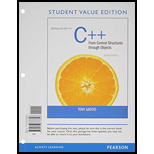
Explanation of Solution
Primitive data type:
Primitive data types are pre-defined data types, which can be used directly by the programmers to declare the variables.
Some of the primitive data types available in C++
Integer:
- Integer is one of the predefined data types. The keyword used for declaring integer data type is “int”.
- It takes up to 4 bytes of memory space to store data. It ranges from -147483648 to 2147483647.
- Example for declaring integer data type is as follows:
- int variable1 = 10;
Floating point:
- Floating point is a predefined data type. The keyword used for declaring floating point is “float”.
- It takes up to 4 bytes of memory space to store data. It ranges from +/- 3.4e +/- 38.
- Example for declaring floating point data type is as follows:
- float variable1 = 10.3;
Character:
- Character is a predefined data type. The keyword used for declaring character data type is “char”.
- It takes 1 byte of memory space to store data. It ranges from -127 to 127 or 0 to 255
- Example for declaring character data type is as follows:
- char variable1 = 'a';
Boolean:
- Boolean is a predefined data type. The keyword used for declaring Boolean data type is “bool”. It stores data in the form of “true” or “false”.
- Example for declaring Boolean data type is as follows:
- bool variable1 = true;
Double Floating point:
- Double Floating point is a predefined data type. The keyword used for declaring double is “double”.
- It takes up to 8 bytes of memory space to store data. It ranges from +/- 1.7e +/- 308
- Example for declaring double data type is as follows:
- double variable1 = 11.34;
Void:
- Void represents null value. The keyword used for void is “void”.
Wide Character:
- Wide Character is a predefined data type. The keyword used for declaring wide character is “wchar_t”.
Example:
The below program demonstrates the usage of primitive data type “integer”:
//Include the header files
#include<iostream>
using namespace std;
//Main function
int main()
{
//Variable declaration
int i, n = 5;
//for loop to print 1 to 5
for (i = 1; i <= n; i++)
{
//print the value of “i”
cout << i << "\n";
}
//Print a new line
cout << "\n";
//Return the value 0
return 0;
}
1
2
3
4
5
Want to see more full solutions like this?
Chapter 11 Solutions
Starting Out with C++ from Control Structures to Objects, Student Value Edition plus MyProgrammingLab with Pearson eText -- Access Card Package (8th Edition)
- Complete the JavaScript function addPixels () to calculate the sum of pixelAmount and the given element's cssProperty value, and return the new "px" value. Ex: If helloElem's width is 150px, then calling addPixels (hello Elem, "width", 50) should return 150px + 50px = "200px". SHOW EXPECTED HTML JavaScript 1 function addPixels (element, cssProperty, pixelAmount) { 2 3 /* Your solution goes here *1 4 } 5 6 const helloElem = document.querySelector("# helloMessage"); 7 const newVal = addPixels (helloElem, "width", 50); 8 helloElem.style.setProperty("width", newVal); [arrow_forwardSolve in MATLABarrow_forwardHello please look at the attached picture. I need an detailed explanation of the architecturearrow_forward
- Information Security Risk and Vulnerability Assessment 1- Which TCP/IP protocol is used to convert the IP address to the Mac address? Explain 2-What popular switch feature allows you to create communication boundaries between systems connected to the switch3- what types of vulnerability directly related to the programmer of the software?4- Who ensures the entity implements appropriate security controls to protect an asset? Please do not use AI and add refrencearrow_forwardFind the voltage V0 across the 4K resistor using the mesh method or nodal analysis. Note: I have already simulated it and the value it should give is -1.714Varrow_forwardResolver por superposicionarrow_forward
- Describe three (3) Multiplexing techniques common for fiber optic linksarrow_forwardCould you help me to know features of the following concepts: - commercial CA - memory integrity - WMI filterarrow_forwardBriefly describe the issues involved in using ATM technology in Local Area Networksarrow_forward
- For this question you will perform two levels of quicksort on an array containing these numbers: 59 41 61 73 43 57 50 13 96 88 42 77 27 95 32 89 In the first blank, enter the array contents after the top level partition. In the second blank, enter the array contents after one more partition of the left-hand subarray resulting from the first partition. In the third blank, enter the array contents after one more partition of the right-hand subarray resulting from the first partition. Print the numbers with a single space between them. Use the algorithm we covered in class, in which the first element of the subarray is the partition value. Question 1 options: Blank # 1 Blank # 2 Blank # 3arrow_forward1. Transform the E-R diagram into a set of relations. Country_of Agent ID Agent H Holds Is_Reponsible_for Consignment Number $ Value May Contain Consignment Transports Container Destination Ф R Goes Off Container Number Size Vessel Voyage Registry Vessel ID Voyage_ID Tonnagearrow_forwardI want to solve 13.2 using matlab please helparrow_forward
 New Perspectives on HTML5, CSS3, and JavaScriptComputer ScienceISBN:9781305503922Author:Patrick M. CareyPublisher:Cengage Learning
New Perspectives on HTML5, CSS3, and JavaScriptComputer ScienceISBN:9781305503922Author:Patrick M. CareyPublisher:Cengage Learning EBK JAVA PROGRAMMINGComputer ScienceISBN:9781337671385Author:FARRELLPublisher:CENGAGE LEARNING - CONSIGNMENT
EBK JAVA PROGRAMMINGComputer ScienceISBN:9781337671385Author:FARRELLPublisher:CENGAGE LEARNING - CONSIGNMENT Systems ArchitectureComputer ScienceISBN:9781305080195Author:Stephen D. BurdPublisher:Cengage Learning
Systems ArchitectureComputer ScienceISBN:9781305080195Author:Stephen D. BurdPublisher:Cengage Learning C++ for Engineers and ScientistsComputer ScienceISBN:9781133187844Author:Bronson, Gary J.Publisher:Course Technology PtrProgramming Logic & Design ComprehensiveComputer ScienceISBN:9781337669405Author:FARRELLPublisher:Cengage
C++ for Engineers and ScientistsComputer ScienceISBN:9781133187844Author:Bronson, Gary J.Publisher:Course Technology PtrProgramming Logic & Design ComprehensiveComputer ScienceISBN:9781337669405Author:FARRELLPublisher:Cengage





